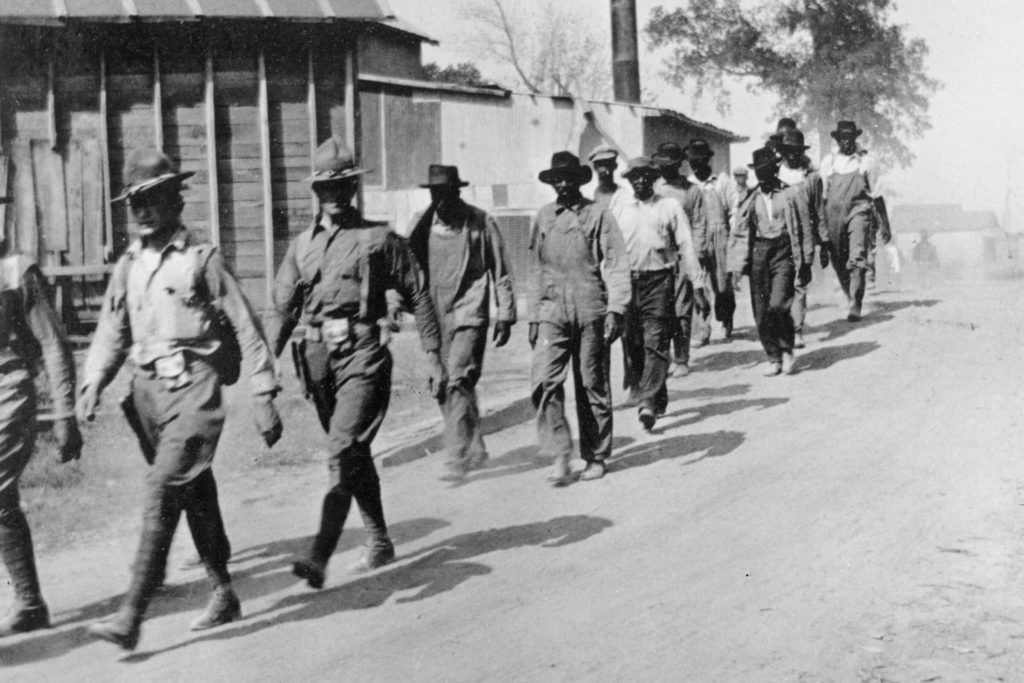In the immediate aftermath of the Massacre, members of the City of Tulsa, Tulsa County, and the Tulsa Chamber’s leadership met with Brigadier General Barrett to coordinate the local response to the Massacre. The meeting was held in Tulsa’s City Hall where they gave the Chamber charge over Tulsa while it was under martial law.
The Chamber formed the Public Welfare Board, all members of which were White. Their refusal to include any Greenwood residents precluded the Greenwood community from influencing public efforts at reconstruction.
Under the authority of the Public Welfare Board, approximately 6,000 Greenwood residents were forcefully detained in what the Tulsa World called “concentration camps.”[1] Those camps, including the Ballpark and Convention Center, were guarded by armed White men including the City’s police and members of the National Guard. Members of the Greenwood community were only able to leave these camps if a White person sponsored them, vouching for their good character.

Greenwood community members were required to wear or carry a green card bearing their White employer’s name while out of the camp. Many Greenwood community residents were forced to work for their White employer under threat of violence and without pay. Those conditions amounted to a badge of slavery.
The Chamber used its property, including money, to secure and pay for the green cards that the City of Tulsa and the State of Oklahoma’s National Guard required every African American adult to carry. Those green cards were adorned with the words “Police Protection” printed on one side, and various other data recorded on the other, including the person’s name, address, and employer. The City of Tulsa issued an order that “any black found on the street without a green card properly filled out was [to be] arrested and sent back to the detention camp.”[2]
The Tribune celebrated the Defendants’ use of the green cards writing, “As always it is the bad who bring misfortune on the good. The bad negro is not helping the cause of his people in any community when he tries mob rule with gun in hand. The city does just what it should do when it gets rid of the negro who cannot give a good account of both his time and conduct.”[3]
Additionally, the Chamber, City, and National Guard required African Americans to work their way out of custody by cleaning up the destruction caused by the angry White mob. At some time on June 2, Brigadier General Barrett issued Field Order Number 4, which decreed that “all able bodied [N]egro men remaining in detention camp at the Fairgrounds and other places in the City of Tulsa [would] be required to render such service and perform such labor as [was] required by the military commission.”[4] The African American Greenwood residents were treated like chattel, reminiscent of slavery.

[1] 5,000 Negroes Held in Fairgrounds Camp, Tulsa Daily World, Jun. 2, 1921, https://chroniclingamerica.loc.gov/lccn/sn85042345/1921-06-02/ed-1/seq-2/.
[2] Scott Ellsworth, Death in a Promise Land: The Tulsa Riot of 1921 75 (1982).
[3] Get a Green Card, Tulsa Tribune, June 8, 1921., at .
[4] Gerald Jerome Smith, Constitutionality of States' Use of Police and Military Force to Arrest, Detain, and Confine American Citizens Because of Race, 27 Okla. City U. L. Rev. 451, 454-55 (2002).

